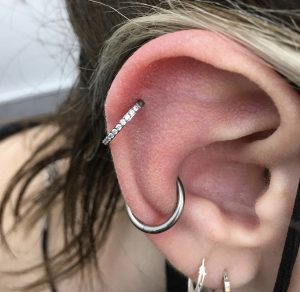How To Protect Your Piercings While Doing Sports
The track and field world championships are just wrapping up this weekend in Eugene, Oregon. As always, we have seen an array of body art ranging from the dainty single-line pieces of Norwegian middle distance runner Jakob Ingebrigtsen to the powerful shoulder roses of Jamaica’s Elaine Thompson Herah. We have also seen a ton of varying shades of hair, and lashes for days. However, piercings are generally less prevalent on the tracks. But what do you do when you want to be able to run, throw jump, or punch to the best of your ability while not compromising your love for body modifications and piercings? Let’s take a look.

Healing a piercing while still engaging in sports and working out is a chapter entirely on its own. You can read more about the special precautions you need to take here, but generally, if you have a season where you play sports more intensely, it is advisable to plan on getting your piercing during the off-season.
Consider removing it to avoid accidents
Once the piercing is fully healed, it is wise to remove it before participating in sports to keep it from getting snagged in clothing or equipment – or inadvertently caught in other players. However, removing a piercing for any longer period of time is never advisable.
Anything more than a few minutes can cause the piercing to begin to shrink – even if you have had it for several years. Therefore, if you play sports that require you to stay active for a prolonged period of time, you can temporarily replace them with non-metallic pieces of jewellery called ‘retainers’. These are only to be worn for no more than 8 hours at a time. Beyond sports, they are usually used for certain medical procedures, such as CAT scans, that will not allow you to have metal piercings fitted.

Taping
Some prefer to tape their piercings while practising sports, especially while it is still healing. First of all, it is a good idea to ask your coach if you will be allowed to do this during practice and games. Secondly, using a regular bandaid is not the best option as the adhesive of the bandaid itself can aggravate the piercing wound. However, there are special waterproof and see-through covers that you can purchase to protect your piercing from both pool water and sweat.
Of course, a belly button, lip or eyebrow piercing will be problematic for wrestlers or rugby players, while runners or high-jumpers may be able to get away with them. In the same way, an ear piercing is most likely fine for a gymnast, whereas an MMA fighter may not want to give their opponent the added opportunity.
Prioritize cleanliness
No matter what type of sports you do, and how you choose to protect your piercing, it is important to always keep it clean and not expose it to dirt and bacteria – especially from any shared sporting equipment and machines/dumbbells at the gym. If you have any questions about how to best care for your piercing, please contact your local Vivid Ink and let our experienced piercers talk you through the best practices to keep you enjoying your jewellery for as long as possible.
